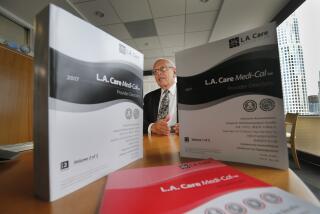Health Care Overhaul Launched
After a year of protests by consumer advocates, brake-slamming by federal officials and hurried fixes by the state, Los Angeles County today begins its foray into mandatory managed care for most Medi-Cal recipients..
For hundreds of thousands of beneficiaries, the change, phased in over six months, means choosing a managed care plan or being assigned to one. For this impoverished population, the old system of shopping for willing Medi-Cal providers--an increasingly frustrating endeavor that often landed beneficiaries in emergency rooms--is being scrapped.
The new system, with estimated annual expenditures of $800 million once in full gear, will pay doctors and plans set monthly fees to take care of the range of medical needs for patients assigned to them. Patients will have a choice between two competing plans, locally organized L.A. Care and the commercial organization Foundation Health. Both of the plans are composed of HMOs. The idea is to control costs while expanding patients’ choices.
The concept of managed care for the poor has its detractors, who are fearful that an often transient and disenfranchised population will not easily navigate the system. But it is the sheer magnitude of the transition that has drawn the greatest concern from consumer groups and many physicians. Los Angeles County’s program, which has been operating on a voluntary basis since April, will be by far the state’s largest such undertaking--and one of the most ambitious in the nation.
Some health-care experts say the success or failure of the so-called “two-plan” approach to Medicaid managed care in California, though it is set to be implemented in a dozen counties, will be judged largely by its performance in Los Angeles County.
Starting today, about 140,000 beneficiaries a month will be added to the managed care rolls, whether by choice or so-called “default assignment.” By midyear, more than 1 million enrollees are expected.
Is the county ready for this?
*
That depends on who you ask. State health officials, jolted repeatedly this year by federal regulators’ demands to improve beneficiary outreach and erase confusion, say they are in good shape.
“We have gone a long way down the road to make sure people have enough information,” said Walter Barnes, assistant chief in the state’s Medi-Cal managed care division.
Since the fall, Barnes said, the state has repackaged once-cumbersome enrollment materials to make them more understandable, launched an intensive advertising effort including radio spots and bus billboards, and educated a range of beneficiaries through community-based organizations.
Federal officials, who delayed mandatory enrollment several times since March because of doubts about beneficiary preparation, say they’re encouraged.
*
“We have been satisfied with [the state’s] continued progress, particularly in outreach and education,” said Richard Chambers, an official with the U.S. Health Care Financing Administration in San Francisco.
Even some consumer groups have softened. “We are guardedly optimistic,” said Les Chun of Consumers’ Union, formerly among the harshest critics of the two-plan model.
But several community and physician groups remain skeptical. Some complained of “dumb mistakes”: enrollment materials too large for mailboxes, for example, and an accidental mailing to foster care beneficiaries who are not part of the managed care program.
Others lamented that enrollment materials have only been distributed in English and Spanish--and that beneficiaries speaking eight other primary languages have been left in the dark. (These people will be sent materials in February and will not be eligible for mandatory assignment until March or April, Barnes said).
Many doctors still worry about possible misassignments--a problem that afflicted other counties such as Alameda early on--and about their office ledgers.
“We are still concerned that the state did not follow the law . . . which provides that [payment rates] be based on the needs of patients and not on economic concerns,” said Dr. Alan Heilpern, president of the Los Angeles County Medical Assn. He and others said primary care doctors may receive $9 or less each month per patient. They will be paid, however, whether or not the patients seek care.
One gauge of the state’s outreach efforts will be the so-called “default rate”--the proportion of beneficiaries who don’t make a choice and are automatically assigned to plans. In Alameda County two years ago, critics complained the initial rate soared to 85%.
Some L.A. County consumer advocates expect Alameda’s initial levels or worse. L.A. Care’s Chief Executive Officer Anthony Rodgers is more optimistic, forecasting an initial rate of 60%, but hoping to whittle that down to 30% by the spring, then to 15%. Barnes predicted a 30% rate.
“If in March, that number is still above 30%, there is going to be some explaining to do,” Rodgers said.
Beneficiaries who have questions or complaints about the program can call a toll-free ombudsman number: (888) 452-8609.
More to Read
Inside the business of entertainment
The Wide Shot brings you news, analysis and insights on everything from streaming wars to production — and what it all means for the future.
You may occasionally receive promotional content from the Los Angeles Times.










